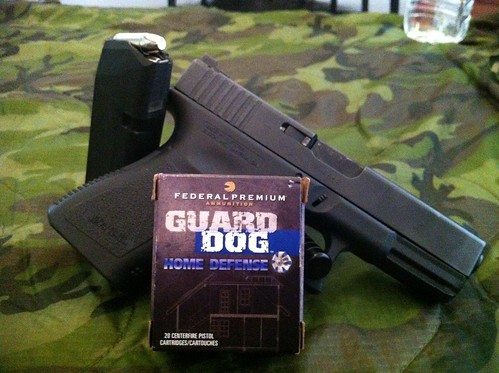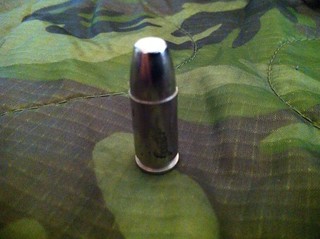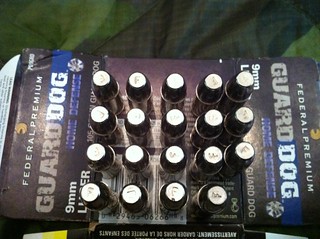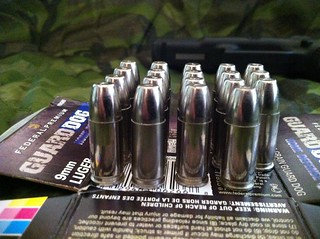
A couple of years ago, Federal Ammunition created something different in the expanding bullet market. The traditional hollow point is designed to expand on impact with something liquid or jelly-like substance, like a body. They won’t expand when they hit something like the wall in your house. The traditional hollow point uses hydraulic pressure (water) to expand. When the bullet hits something soft and liquid filled like a person it is going about the speed of sound (Mach 1), the tissue on the outside of the bullet passes around it, but the fluid caught in the hole creates extreme pressure from the speed of the bullet. The pressure pushes the bullet to deform. Engineers create the way it deforms so the bullet flowers out in some way to make it bigger to do more damage to the tissue as is passing through.
The technology for bullet construction is nothing short of amazing. When I think back to what there was 20 years ago and the things like “Black Talons” and .45 flying ashtray, the bullet construction is incredible. The bullets are helping to stop people faster and better than ever before.

Part of the progress happened because the FBI created a standard ballistic test in 1988 after the famous Miami Dade shooting in which two armed gunmen where almost able to overcome 8 trained and armed agents. One of the problems the FBI found after studying the shooting was the ammunition did not preform anything like what they thought it would. The test is simple and designed around what was available in the late 1980s.
The test is simple, shoot ammo through different mediums into 10% ballistic Gelatin and at different distances (the complete test outline can be found here). The requirements are simple, a handgun bullet must penetrate between 12 and 18 inches every time to pass. This test is antiquated and I know we can do better to prove how ammunition will perform in the real world than this test with modern equipment. We can measure things like the amount of force the bullet transfers to the gelatin and how fast. With high speed cameras, we can measure the temporary wound channel or stretch cavity in the gelatin. I also think we can find a better medium than ballistic gelatin. I know it’s flawed for the simple fact that the test assumes that the bullet will not penetrate as far in an actual person. Look at how thick you are at the heart and lungs area. Are you between 12 and 18 inches thick? So I think the egg heads need to get to work on this before ammunition can advance again.

Currently the Guard Dog ammo does not pass the FBI test for use as law enforcement ammo, and because of this, I’m not sure it will catch on. But I think Federal could also work the ammo over a little bit more to make it pass. It won’t pass the test is the biggest reason most people won’t use this ammo. For me, it’s actually a reason for me to use it.
First, I think the round will do fine as a man stopper, right up there with Corbon DPX, Winchester Rangers, Speer Gold Dots, and many others on the market. Handguns are really bad at stopping people and I don’t think someone will notice the difference after being shot with any of the above rounds. I actually like the fact that it won’t pass the test. It’s my trick in court. I use ammo that isn’t even lethal enough for law enforcement to use.

From my 9mm, I want something that won’t over penetrate and that will dump energy into the target quickly. Part of the problem with the 9mm and even 5.56 is that they tend to pock straight through without dumping any energy into the target. So, if you don’t hit anything vital, the person that got shot might not even know it.
From a lot of the tests I’ve been reading about and films I’ve been watching on YouTube, this round makes quite a splat when it hits. It’s also going out of the barrel pretty quickly, at almost 1250 fps. One of the reasons it’s believed that the .357 Magnum did so well was its incredible speed.
The Guard Dog ammo is constructed completely different than normal. It is an expanding full metal jacket round. The bullet has a metal jacket, lead core and a plastic tip. The plastic sits in the front of the bullet under the jacket with the lead core behind it. The jacket is slit six times around the front half. When the bullet hits something, anything, the plastic crushes and the jacket splits at the pre-cut spots. The lead core following it squishes the plastic and deforms the bullet. The jacket petals out like a flower to create the expansion.

Every test I looked at when I chose the round and doing research for this post had the bullet expand the same way every time. That was almost impossible 15 years ago and now it’s almost normal. Even through different mediums, these bullets expand the same way.
In the FBI test, this bullet really had problems when it penetrated car glass, and steel. This matters more to law enforcement than to me as a civilian, it’s something I have to keep in mind when I carry this round. If I was carrying 9mm FMJ, it wouldn’t have any problem punching through glass and steel, these bullets will have difficulty. I’m really not concerned about it, just something to know.
These are good bullets and I expect the next couple of generations coming to be amazing. I’ll keep carrying these for the time being and just keep in mind the shortcomings of penetration these bullets might have.
Links to Check out:
Stay Safe,
Ben
[AFG_gallery id=’16’]
I’ve been carrying the .45 ACP 165 grain Guard Dog in both my daily carry the Glock 41 and my running gun the Glock 36. I think it was an article I read in American Rifleman that turned me on to them. I too am worried about over penatration as I am responsible for every bullet that leaves my firearm should the need ever arise. I would like to see a YouTube Video on the performance of this ammo. I’ve read a few nay sayers comments about it not passing the FBI test because of the rapid expansion and it not being able to penetrate glass or steel. Oh well, can’t make everyone happy I guess. My morning payer, Lord please don’t let me have to use my carry weapon today, but if I do, please let me shoot straight.
This article by Ben Branam, and the comment by Samuel Reich, is the most logical & well thought out reviews of [the] Fed GD 9mm cartridge. Lots of thought provoking info here. As a licensed carry, approaching geezer status, stopping a car is not the highest threat on my radar. Stopping a drug fueled punk hoping to stomp me dead is the top of my list. Having a couple of 102 grain projectiles entering and dumping energy into the perp’s lung cavity seems to me the best option to remain alive. Thanks again to the afore noted authors. And – I never have and never will live in fear!
Awesome thoughts! Thanks for reading and leaving a comment. Let me know if there is anything you want to read about.
The density of human lungs is 1/3 that of water or most other tissue. Therefore, if your aim point is the chest you need very little penetration but very rapid expansion. There is only 2 or 3″ of flesh before one enters the inside of the chest cavity most of which is taken up by lungs.
That’s one of the reasons I like the Guard Dog ammo. But that is a very good point that I never thought about before.
Thanks for the info.